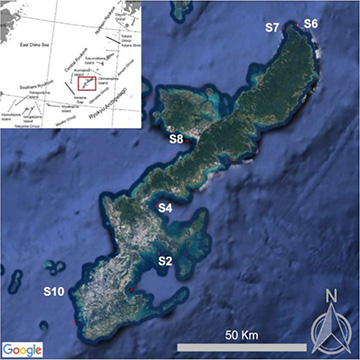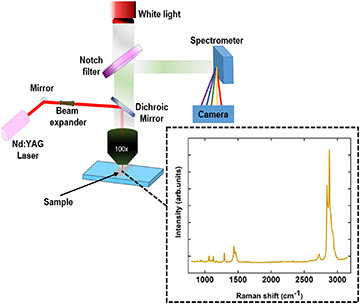![]()
A small microplastic particle, dissolved in a seawater sample. [Image: OIST]
Two recent research studies have highlighted the value of optical techniques—in particular, Raman spectroscopy—in assessing the extent and potential environmental threat of microplastics in marine environments.
In one study, researchers at the Okinawa Institute of Science and Technology (OIST), Japan, combined micro-Raman spectroscopy with optical tweezers to get a grip on the slippery issue of microplastic concentrations and compositions in seawater (Sci. Total Environ., doi: 10.1016/j.scitotenv.2020.143927). And in the other, a team of scientists in Israel, France and the United States used Raman to assess the level of airborne microplastics hovering above the surface in remote marine areas (Commun. Earth. Environ., doi: 10.1038/s43247-020-00061-y).
Sniffing out tiny plastic particles
Sensing microplastics—commonly defined as plastic particles less than 5 mm in size—has emerged as a focus of optical research in recent years, as the extent of the problem of plastic pollution, especially in the marine realm, has increasingly captured headlines (see “Detecting Microplastics with Optics,” OPN, November 2020). So-called small microplastics, with diameters of less than 20 µm, have rung particular alarm bells, representing a potential, and largely unquantified, biological and toxic hazard to marine ecosystems and organisms.
Among optical techniques, micro-Raman spectroscopy has a key role in the investigation of these small microplastics. In Raman, inelastic scattering of photons against a molecule (Raman scattering) gives rise to an energy shift tied to vibrational modes in the molecule; the resulting spectrum of scattered light provides information about the molecule’s structure and chemical composition. It’s a great fit for studying small microplastics—in part because it sports substantially greater spatial resolution (to around 1 µm), wider spectral coverage and other advantages relative to a popular alternative technique, Fourier transform infrared (FTIR) spectroscopy.
Unfortunately, it’s tough to capture these tiny particles for Raman analysis when they’re suspended in seawater—and, as a result, Raman study of microplastics from marine water has typically involved filtering particles out of seawater for “dry” study in the lab. That’s a double disadvantage, as it substantially slows down the analysis and also takes the plastics out of the seawater matrix, potentially skewing the analysis.
Putting Raman and tweezers together
The experimental setup used by the OIST team, along with a characteristic Raman spectrum, drawn from a 15-µm polyethylene particle in a seawater sample. [Image: Ripken et al., Sci. Total Environ., doi: 10.1016/j.scitotenv.2020.143927 (2020); CC BY-NC-ND 4.0] [Enlarge image]
To get around these problems, the OIST team—including grad student Christina Ripken, OSA member Domna Kotsifaki, and OSA Fellow Síle Nic Chormaic—turned to a technique introduced last year by researchers in France and Italy: combining Raman spectroscopy with another, Nobel Prize-winning tool, optical tweezers.
In the team’s setup, a 532-nm Nd:YAG laser beam, fired through a high-numerical-aperture microscope objective into a seawater sample, does double-duty both as a trapping laser, holding suspended microplastic particles in place, and as a Raman excitation beam. A commercial micro-Raman spectrometer, integrated into the setup, then reads the Raman signal for information on the particle’s chemical composition, and a CCD camera captures the particle’s shape and size.
Real-time assessment in a “blue zone”
Using the combined tweezer-Raman setup, Kotsifaki noted in a press release accompanying the research, “meant that we didn’t need to filter out the plastic first, so we could see if there was plastic embedded within organic material or if any trace metals were present and the concentration of the plastics in the sampled seawater.”

The OIST team collected and analyzed seawater samples at six sites around Okinawa. [Image: OIST]
The team put the system to work on microplastic seawater solutions trawled from six surface-water locations around Okinawa—a potentially interesting area because it has been identified as a “blue zone,” characterized by exceptional human longevity. The combined tweezer-Raman setup, which allowed assessment of microplastics in real time, revealed that dissolved microplastics were present in all areas sampled—constituting an average of 17% of the particles found in the samples, and as much as 25% of the of the particles in a sample in one of the six areas. The study also offered a better view of how the concentration and composition of the plastics varied with levels industrial activity, fishing and human occupancy.
The researchers hope that the research can influence policy and that “it will help boost the environmental research area,” according to first author Ripken.
Measuring airborne microplastics
Another research group—involving scientists at the Weizmann Institute of Science, Israel; the Sorbonne Université and Institut Universitaire de France; and the University of Maine, USA—has trained Raman spectroscopy on microplastics not dissolved in the ocean, but in the form of aerosols above the ocean surface. While airborne microplastic particles have been previously observed above nearshore waters, the team was interested in finding out whether the tiny particles were being carried to remote, supposedly pristine ocean areas.
To find out, the researchers collected aerosol samples in a remote part of the North Atlantic Ocean during a cruise of the research schooner Tara, using a collector perched high on one of the vessel’s masts (to avoid capturing aerosols emanating from the schooner itself). Back in the lab, the team then used micro-Raman spectroscopy to chemically characterize the aerosol samples.
Ubiquitous presence
The team found—disturbingly, but perhaps not surprisingly—that the atmosphere above these remote waters was itself loaded with microplastic particles, likely originally sourced from plastic bags and other plastic waste discarded hundreds of kilometers away and carried far afield by air currents. And the team believes that its analysis, which was limited to particles larger than 5 µm, likely underestimates the presence of plastic microparticles in the air of these remote marine areas.
Ilan Koren of the Weizmann Institute, one of the study’s corresponding authors, suggested that the ubiquity of these tiny plastics in the remote ocean, as revealed by the Raman analysis, bodes ill for efforts to contain and reduce microplastic pollution in the ocean.
“Like all aerosols, microplastics become part of the large planetary cycles—for example, carbon and oxygen—as they interact with other parts of the atmosphere,” Koren said in a press release accompanying the study. “Because they are both lightweight and long-lived, we will be seeing more microplastics transported in the air as the plastics that are already polluting our oceans break up, even if we do not add any further plastics to our waterways.”

